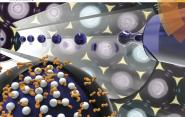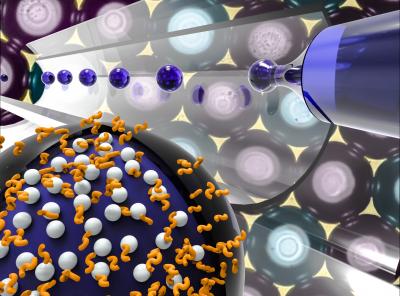Osuji Lab Study On Microcapsules Makes Cover Of Soft Matter

A new technique for making microcapsules developed in the lab of Chinedum Osuji has a potential to impact the fields of food science, medicine and cosmetics.
Using a method known as microfluidic interfacial complexation, the researchers can fabricate microcapsules rapidly in one-step with shells composed of polyelectrolyte-particle or  polyelectrolyte-protein complexes– plus, they can make the shells substantially thicker than what is possible using conventional methods, while exercising control over their mechanical properties. The research was featured on the cover of the October 2015 edition of Soft Matter.
polyelectrolyte-protein complexes– plus, they can make the shells substantially thicker than what is possible using conventional methods, while exercising control over their mechanical properties. The research was featured on the cover of the October 2015 edition of Soft Matter.
Gilad Kaufman, lead author of the study, said the advantage of their method is that it allows the microcapsule to be made in a single step with sufficient control over the mechanical and release properties. “The key thing here is that we can make the capsules really easily, and we can make their shells really thick,” said Kaufman, a graduate research assistant in Osuji’s lab in Chemical & Environmental Engineering department.
Composite polyelectrolyte microcapsules offer considerable flexibility in terms of controlling physical properties, such as permeability and mechanical strength. That flexibility is crucial for a wide range of applications that require the ability to target specific chemical species and release active ingredients. The problem is that common methods for the fabrication of such microcapsules rely on a multi-step process that is often cumbersome and time-consuming. That makes large-scale fabrication difficult.
In Osuji’s lab, the researchers generate water-in-oil emulsions using microfluidic technology. Through electrostatic interactions and hydrogen bonding, polyelectrolytes (a kind of charged polymer) and nanoparticles or globular proteins form complexes across the water-oil interface and create a shell around the water droplet.
“The idea is that the water contains nanoparticles which are charged, and the oil contains a polyelectrolyte” Kaufman said. “They come together at the interface and they form an elastic sheet that protects the drop.”
The resulting microcapsules are uniform in size, mechanically robust, and have nanoparticle-polymer composite shells with a thickness of up to 3,000 nanometers.
“The benefit of having a very thick shell is that it’s extremely stiff compared to thin shell capsules,” Kaufman said. “If the capsules are going to be used as delivery vehicles, they require sufficient mechanical integrity so that their passage through constrictions will not result in rupture and premature release of a payload, for instance.”
What’s more, the researchers were also able to form microcapsules of different shapes, which can provide more surface area for applications that require it.

